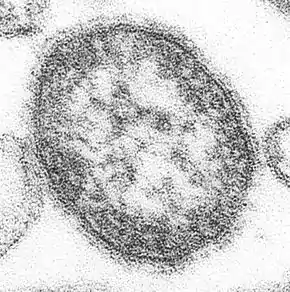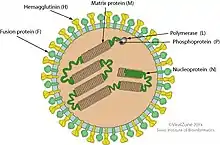Morbillivirus
Morbillivirus is a genus of viruses in the order Mononegavirales, in the family Paramyxoviridae.[1][2] Humans, dogs, cats, cattle, seals, and cetaceans serve as natural hosts. This genus includes seven species. Diseases in humans associated with viruses classified in this genus include measles; in animals, they include acute febrile respiratory tract infection.[3]
| Morbillivirus | |
|---|---|
 | |
| Measles morbillivirus electron micrograph | |
| Virus classification | |
| (unranked): | Virus |
| Realm: | Riboviria |
| Kingdom: | Orthornavirae |
| Phylum: | Negarnaviricota |
| Class: | Monjiviricetes |
| Order: | Mononegavirales |
| Family: | Paramyxoviridae |
| Subfamily: | Orthoparamyxovirinae |
| Genus: | Morbillivirus |
| Species | |
| |
Genus
| Genus | Species | Virus (Abbreviation) |
| Morbillivirus | Canine morbillivirus | Canine distemper virus (CDV) |
| Cetacean morbillivirus | Cetacean morbillivirus (CeMV) | |
| Feline morbillivirus | Feline morbillivirus (FeMV) | |
| Measles morbillivirus | Measles virus (MeV) | |
| Ovine rinderpest | Peste-des-petits-ruminants virus (PPRV) | |
| Phocine morbillivirus | Phocine distemper virus (PDV) | |
| Rinderpest morbillivirus | Rinderpest virus (RPV) | |
Structure

Morbillivirions are enveloped, with spherical geometries. Their diameter is around 150 nm. Genomes are linear, around 15-16 kb in length. The genome codes for eight proteins.[2][3]
| Genus | Structure | Symmetry | Capsid | Genomic arrangement | Genomic segmentation |
|---|---|---|---|---|---|
| Morbillivirus | Spherical | Enveloped | Linear | Monopartite |
Life cycle
Viral replication is cytoplasmic. Entry into the host cell is achieved by virus attaching to host cell. Replication follows the negative-stranded RNA virus replication model. Negative-stranded RNA virus transcription, using polymerase stuttering, through co-transcriptional RNA editing is the method of transcription. Translation takes place by leaky scanning. The virus exits the host cell by budding. Humans, cattle, dogs, cats, and cetaceans serve as the natural hosts. Transmission routes are respiratory.[2][3]
| Genus | Host details | Tissue tropism | Entry details | Release details | Replication site | Assembly site | Transmission |
|---|---|---|---|---|---|---|---|
| Morbillivirus | Humans, dogs, cats, cetaceans | None | Glycoprotein | Budding | Cytoplasm | Cytoplasm | Aerosols |
References
- Rima, B; Balkema-Buschmann, A; Dundon, WG; Duprex, WP; Easton, A; Fouchier, R; Kurath, G; Lamb, R; Lee, B; Rota, P; Wang, L; ICTV Report Consortium (December 2019). "ICTV Virus Taxonomy Profile: Paramyxoviridae". The Journal of General Virology. 100 (12): 1593–1594. doi:10.1099/jgv.0.001328. PMC 7273325. PMID 31609197.
- "ICTV Report Paramyxoviridae".
- "Viral Zone". ExPASy. Retrieved 13 August 2015.
- Amarasinghe, Gaya K.; Bào, Yīmíng; Basler, Christopher F.; Bavari, Sina; Beer, Martin; Bejerman, Nicolás; Blasdell, Kim R.; Bochnowski, Alisa; Briese, Thomas (7 April 2017). "Taxonomy of the order Mononegavirales: update 2017". Archives of Virology. 162 (8): 2493–2504. doi:10.1007/s00705-017-3311-7. ISSN 1432-8798. PMC 5831667. PMID 28389807.